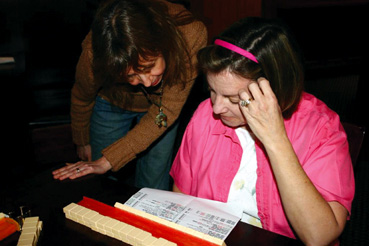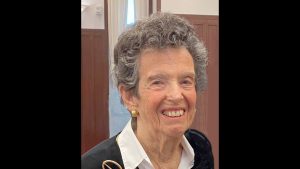Game is not just for bubbies anymore
Published May 29, 2007
You can find these groups of ladies at local restaurants such as Houlihan’s, Hunan Empress, Marriott West and Pastries of Denmark. At first they look like all the other customers enjoying a meal together. Then as the lunch rush is completed, they clear the tables and set up the games and start saying things like: “one bam, three dot, west, red and same.” They are the new generation of mah jongg players. The ancient Chinese game with the American twist is alive and well in the St. Louis Jewish community and gaining new players of all ages.
There are many theories on how the game made its way to the United States from China. It was mentioned in a paper written by anthropologist Stewart Culin in 1895. It became a fad in the 1920s and many different rules developed. In 1937, 32 Jewish ladies got together to try and standardize the game and founded the National Mah Jongg League.
This year the league is celebrating its 70th anniversary. Today there are more than 275,000 members of the organization which continues to publish yearly standard hand cards, answer questions, make rulings on the game, sell merchandise, try to help people replace missing tiles and sponsor tournaments and cruises. They also offer the opportunity for groups to raise funds by combining their card orders.
This year Robin Shulman purchased more than 200 cards for B’nai Amoona from the league based on pre-orders from members, friends and the synagogue gift shop. Several area synagogue gift shops carry a variety of mah jongg themed merchandise. There are items for play such as travel size mah jongg sets and items for fun including: key chains, shmeer spreaders, coin purses, T-shirts, coasters and more.
In the St. Louis Jewish community there are several ongoing groups who play at synagogues, retirement centers and the homes of individual players. Several congregations and organizations have sponsored classes to teach the game, though most players said that may not be the most effective way to learn how to play by itself. Charlene Taber recalled taking a class and being totally confounded. Fannye Baum also took a class but said the lessons didn’t stick. All the players interviewed for this article said “on the job playing” is the best way to learn the game.
Laurie Berwald remembered the game as something her parents and grandparents played. Though her mom has played for close to 50 years, Berwald learned the game with some other women who decided to teach themselves. She recalled the group played very, very slowly during those learning stages. She also needed to place a few calls to her mom to verify the rules and check out the legalities of certain moves. Berwald’s weekly mah jongg group plays while their kids are in school or otherwise occupied.
“It’s very relaxing,” Berwald said. “It is my two-and-a-half hour escape from the realities of everyday life.”
Jerri Livingston recalled coming home from school and seeing her mother and the ladies playing mah jongg. Livingston started playing when the late Phyllis Kaplan chose the topic of mah jongg from ideas solicited for interest groups as part of Brandeis University National Women’s Committee. Livingston went to play and got hooked on the game.
This fall Livingston taught a class on the game at Shaare Emeth based on a specific request from the congregation’s Contemporary Women of Reform Judaism. There was a good response to the class with participants of various levels of knowledge from “without a clue” to those able to hold their own in a game. Livingston had ladies from her mah jongg group to assist with teaching the newer players.
Livingston’s group meets weekly on Thursday afternoons at Houlihan’s. The group is very protective of their time together and work diligently to schedule their lives around their games. They start by having lunch together and then playing mah jongg for a couple of hours. The women have become very close and supportive of each other over the years. They have been there to help each other through good times and bad.
“I came home from the hospital on a Thursday morning after having my mastectomy for breast cancer,” Livingston said. “On Thursday afternoon, the girls brought over lunch and we played maajh. We are always there for each other. It’s pure and simple.”
Livingston’s mother Aronetta Persky is also part of the Houlihan’s group. She remembers playing as a young newly married when friends or couples got together. The women played mah jongg and the men played cards, said Persky. Today she enjoys playing with the group because it helps keep her mind active and for the socializing.
There’s no question that socializing is a strong part of the attraction for the groups which get together on a regular basis. Some women bring knitting, stitchery or something else to do while sitting out if there are too many players. There is always time for schmoozing and catching up with each other and of course, there is always food.
“It’s the opportunity to be with other women, the camaraderie,” Marsha Schankman said. “It’s building sisterhood.”
Then there is the younger generation who are learning to play the game. There are several CD-ROM versions and on-line games available. Several local players said they taught the game to their children which they has come in handy when there is a need for a substitute player. Learning to play mah jongg was the most popular lesson when Virginia Horowitz taught the game to eighth grade students in the American Jewish Experience class at Central Reform Congregation. Students frequently requested the opportunity to continue playing the game.
“Now we have all these younger mah jongg mavens running around playing the game with their bubbies and parents,” Horowitz said.















